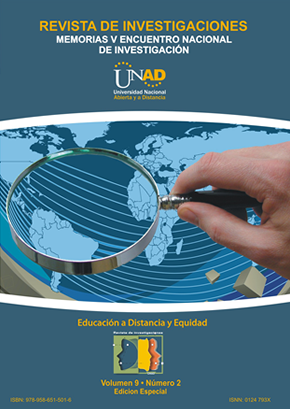Cuando la REVISTA DE INVESTIGACIONES UNAD recibe la postulación de un original por parte de su autor, ya sea a través de correo electrónico o postal, considera que puede publicarse en formatos físicos y/o electrónicos y facilitar su inclusión en bases de datos, hemerotecas y demás sistemas y procesos de indexación. REVISTA DE INVESTIGACIONES UNAD autoriza la reproducción y citación del material de la revista, siempre y cuando se indique de manera explícita el nombre de la revista, los autores, el título del artículo, volumen, número y páginas. Las ideas y conceptos expresados en los artículos son responsabilidad de los autores y en ningún caso reflejan las políticas institucionales de la UNAD
Estado del arte de la movilidad humana en el eje cafetero
This research was carried out in order to develop critical thinking about the comprehension that people have on human mobility, all around the ecoregion which conforms The Coffee Belt; taking into account all the aspects that have been learned, what has been ignored, and how far this knowledge goes, so that we can understand it in a synthetic way. Facing those aspects is possible, applying the research methodology which is called “State of the Art”,
theory that has been the support for proposing the following items:
• Problems that have been analyzed around a problematic situation;
• How is the topic defined, within the different studies?
• Differences among a variety of definitions and methods which are used in the different ways to face the problem.
The research process goes farther of a “documental inventory”, focused on the analysis and interpretation of the information; these aspects made it easy an optimum integration of data
and bibliographic revision, which in the case of this paper, will be about “the human mobility all around the ecoregion which conforms The Coffee Belt”.
The answer to the multiple experiences and actions about human mobility, that have not been systematized, will guide the discussion on this topic and its pertinence to the Coffee Belt
Region, all the same, for the further scientific development of the seed research about human mobility in ECSAH.
The aspect that motivated this study was the lack of a data base about other research studies or systematic approaches carried out around the human mobility. The methodological process defined for the process from the seed research, started with the differentiation process of some categories related to the human mobility: immigrants, people who live in a place for a short period of time, displaced people, people who have come back, people who have been victims of traffic, and tourists; this paper does not present, so far, the analysis of the tourism, trasporters and immigrants category, since it is under construction.
Trough the description of categories, the researchers visited different government offices: Governors’ offices, majors’ offices, universities, bookshops in the region, and non government offices, in order to collect all the available information about human mobility in the Coffee Belt Region.
As an instrument for the data collection, the researchers adopted a format related to an analytical summary, in which the information obtained in the research process was organized.
All this information was obtained in the places mentioned above.
When the information was collected, a category was given for each group, and using statistic and triangulation analysis from the systematic focus proposed by Uri Bronfrembrener, applying the four categories of micro system, macro system, mesosystem, and exosystem; an approach to the phenomena was searched during nine months.




